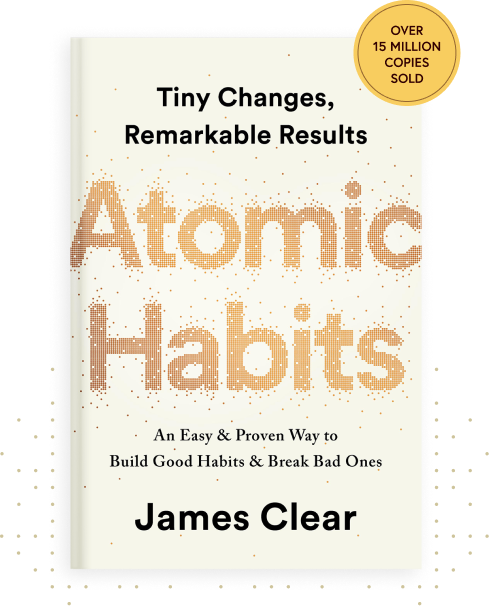Everyone has habits, good and bad. They’re the routine actions that we all perform every day. They can be as simple as brushing your teeth in the morning, or as complex as keeping a journal.
My habits? Mostly bad, apparently. I procrastinate, mutter under my breath, and overthink decisions. Any decisions. I have this all on excellent authority. She’s been taking notes for three decades.
The thing is, I don’t think about my habits much, unless they’re spotlighted. When I do, I just consider them part of being me, essential components of my identity. However irritating they might be to others.
But what if I could change the bad habits, even the ones that seem ingrained and permanent? What if I could replace them with better ones, maybe even making myself a better person?
It’s an enticing prospect. And James Clear shows how you can do it, in his book “Atomic Habits: An Easy and Proven Way to Build Good Habits and Break Bad Ones.”
The Structure of Atoms
The book’s title plays on two senses of the word atomic. One, atoms are really tiny. So are the initial changes you can make to your habits. Two, when atoms all do the same thing at the same time, you get atomic power. And the incremental effect of lots of tiny changes to your habits can be – or feel – equally huge.

For Clear, all habits share a clearly defined structure. It’s in four parts: cue, craving, response, and reward. The cue triggers a craving, which motivates a response, which provides a reward, which satisfies the craving. Over time, the reward becomes associated with the cue.
So the cue might be the smell of coffee, or just entering the kitchen at the same time every morning. You feel you really need a coffee. That’s the craving.
So you make one. That’s the response. You get your coffee. And that’s your reward. And because you enjoy it, you’ll probably go through the whole process again tomorrow morning.
Breaking Bad Habits With the Four Laws
The book develops the four-part structure into four laws for habit change. If you want to develop a good habit, make the cue obvious. Then, make the new habit attractive, to develop a craving. Third, make the response something you can do easily. Finally, make your new habit satisfying, so that you’ll repeat it.
Want to break a bad habit? Hide the cue. Make the habit unattractive to you. Make the response difficult, and the outcome unsatisfying. Easier said than done, you might think. But “Atomic Habits” talks you through how you can do it.
The Sky’s the Limit?
And the results? Let’s consider habits you can measure easily. If you look at making a one percent improvement in what you’re doing daily, then after a year, you’ll be 37 times better at it. That’s the math. Of course, 37 times improvement on a bad starting point can still represent modest results.
There has to be a ceiling, too. I’m not going to get that Olympic track cycling gold, ever. But I might be able to spend enough time on the exercise bike to do myself some real good, and not end up a wheezing wreck.
Forget About Goals
The book makes some bold claims in other directions, too. Setting goals is a waste of time, for example. At least, it is if you don’t have the processes in place to achieve them. And even reaching a goal can be unsatisfying, because you feel you have to set another one.
True happiness, the book argues, comes from having robust systems for personal improvement, not reaching milestones. Whether you agree with that or not, it’s food for thought.
All Change for a Better You
And the ultimate goal of these systems? Identity change. That’s right. It’s that fundamental. Changing your habits can actually make you a different, better version of yourself. That’s quite a challenging thought. But the book’s nothing if not a practical manual, and Clear’s tone throughout is brisk and can-do.
I went on the exercise bike yesterday, for the first time in a while. I repeated the effort today and went a tiny bit further. No, I won’t be entering the Tour de France anytime soon, and I don’t know whether I’ll become a different person. But I do feel I’ve got a plan to feel a bit fitter. And that’s got to be progress.
Listen to Our “Atomic Habits” Book Insight
We review the best new business books and the tested classics in our monthly Book Insights, available as text or as 15-minute audio recordings.
So, if you’re a Mind Tools Club member or corporate user, listen to the “Atomic Habits” Book Insight now!
If you haven’t already signed up, join the Mind Tools Club and gain access to our 2,400+ resources, including 390+ Book Insights. For corporate licensing, ask for a demo with one of our team.

About the Author:
Content Editor/Writer Simon Bell knows how to explain things as simply as possible. He spent 20 years in educational publishing, before working on the popular “For Dummies” books. At Mind Tools, he’s particularly proud of the Skillbook he wrote about managing stress, and his article on Porter’s Five Forces – one of our most popular resources. He also helps to produce the influential reports created by our in-house Impact and Insights team. Simon enjoys learning about history, and sharing new music with his sons. And his favorite advice is about balancing work and life: “Know when you’ve done enough at work – then go home!”




